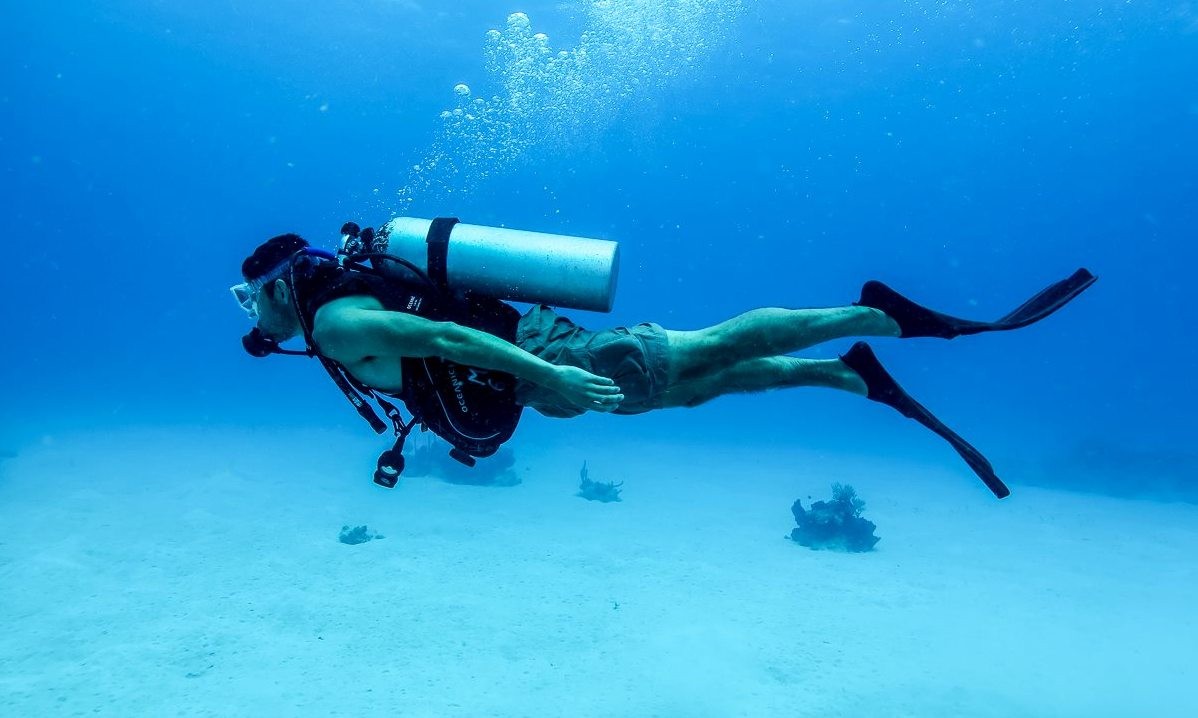Diving Sites in Port Blair



-
Jul 25, 2025
When getting ready for an exhilarating scuba dive adventure, especially in places like Havelock Island, it is essential to know your scuba diving equipment. One of the most important pieces of equipment is the scuba tank. However, there is an important consideration for scuba tanks that most people overlook, and that is all the markings on the tank itself whether they are stamped or etched. The markings may appear confusing or technical at first glance, but they provide vital information that will help keep a diver safe and ensure you have the best experience underwater. Typically, tank markings are on the neck or shoulder part of the tank, and they are placed there by the manufacturer. They are not just random numbers and letters, but actually codes that reflect the material (aluminum or steel) of the tank, its working pressure, its volume, its hydrostatic test date, its serial number, and if it complies with the DOT (Department of Transportation) or ISO (International Organization for Standardization) certification standards. Knowing this important information allows divers to select the right tank for diving, and helps to ensure that all diving equipment used in the activity meets safety standards.
For example, tanks stamped with “AL” are made of aluminum, which is popular in tropical areas such as the Andaman Islands because aluminum is resistant to corrosion. Tanks made of steel, usually stamped with “ST” are more rugged and mostly used in cold waters and technical diving, but they are negatively buoyant, which will affect your weight management. The working pressure commonly marked either “3000 PSI” or “207 BAR”, tells you how much air the tank holds to a safe pressure. This is very important when considering duration and depth on your dive. The tank capacity is also usually expressed in cubic feet (for example, 80 cu ft) or liters. Hydrostatic test date is equally important, the hydrostatic test date means that the tank has been pressure-tested and it comes in compliance with current vest safety requirements. Hydro testing is usually done every five years and the date is marked in an “MM-YY” format.
You should never dive with a tank that has failed hydro testing as this is dangerous and is considered non-compliance with most professional diving regulations. Each tank has a serial number and regulatory information like “DOT-3AL” or “ISO 9809” that indicates where the tank originated, how it was manufactured, and whether it adheres to legal standards.
When diving with a service like Dive Andaman, all this is taken care of (all you have to do is dive). At Dive Andaman, they guarantee snorkel and scuba tanks are well-maintained, tested regularly, certified for use, and that's peace of mind while you are diving the underwater world of Havelock Island.
However, if you know how to read these markings yourself, it makes you a safer scuba diver, and increases your confidence and capability of using your scuba gear. In summary, learning the meaning of scuba tank markings is an important scuba diving skill for any diver. All these markings inform you of the safety, volume, and uses of the tank for your dive. Whether you are a beginner, or an experienced diver, knowing the finer details about your equipment can only improve your scuba diving experience below the water, as well as safety and efficiency.
What Are Scuba Tank Markings?
.jpg)
Scuba tank markings are permanent stamps on the neck or shoulder of a diving cylinder. These alphanumeric codes and symbols indicate key details such as:Tank material (Aluminum or Steel)
- Working pressure
- Hydrostatic test dates
- Serial number
- Tank capacity
- Manufacturer details
- Standard compliance codes (e.g., DOT or ISO)
Key Tank Markings Explained
Let’s break down the most common scuba tank markings and what they mean:
1. Tank Material Code
Look for markings like:
- AL or ALUMINUM – Indicates aluminum construction
- ST or STEEL – Indicates steel construction
Each material has different buoyancy characteristics, so knowing this helps in proper weight adjustments during your dive.
2. Working Pressure
- Typically marked in PSI (pounds per square inch) or BAR.
- Example: 3000 PSI or 207 BAR
This tells you the maximum pressure to which the tank can be safely filled.
3. Tank Capacity
- Expressed in liters or cubic feet.
- Example: 80 cu ft (11.1L)
This indicates how much gas the tank can hold when filled to its working pressure.
4. Serial Number and Manufacturer
- Example: Luxfer L1234567
- Identifies the tank’s origin and helps track its inspection and service history.
5. Hydrostatic Test Date
- Format: MM-YY
- Example: 03-24 means last tested in March 2024.
Hydro testing is required every 5 years to ensure the tank can safely hold pressure.
6. Regulatory Approval Codes
- DOT-3AL (U.S. Department of Transportation)
- ISO 9809 (International Organization for Standardization)
These codes indicate the tank meets safety standards in its country of use or internationally.
Why Understanding Tank Markings Is Important?
Knowing how to identify scuba tank markings is an essential skill for all divers, regardless of whether you are a novice initiating in the sport or a seasoned expert. The markings on your scuba tank, which may either be etched or stamped on the shoulder or neck of the tank, have important implications for your safety and the quality of your dive. While markings identify the material of the tank (either aluminum or steel), which has implications for buoyancy and weight requirements underwater, they also indicate the working pressure and how much air the tank can actually hold safely. This is important for planning dive time and depth.
Hydrostatic testing dates also mark critical dates for confirmatory testing and certification for high pressure, or the tank may rupture. The risks of using an out-of-date or untested tank can be extremely high. While cylinder capacity, regulations compliance (DOT or ISO), and serial numbers can be helpful to note your scuba tank specifications, it is critical to know that tanks are up to acceptable safety standards at all levels of diving, domestically or internationally. Without a knowledge of tank markings, scuba divers may unknowingly scuba dive with unsafe or unsuitable tanks, which can increase the potential risk of divers becoming incapacitated or running out of air. Considering and learning the ability to identify and interpret tank markings will make you a more advanced diver.
- Safety: Ensures the tank is certified and pressure-tested.
- Compliance: Prevents the use of expired or unauthorized tanks
- Efficiency: Helps you choose the right tank size and material based on your dive profile
Learn More with Dive Andaman
At Dive Andaman we put equal emphasis on diver education and safety, as we do on the more thrilling aspects of diving. From the moment you arrive at the dive centre you'll be one-on-one tutored by any one of our professional dive instructors. They will show you your equipment every dive, ensuring you feel safe and comfortable. Whether you are a novice or continuing your dive education by enrolling in your next scuba certification course in the Andaman Islands, we'd like to educate you in having smarter diving, safer diving and ultimately diving with confidence. Understanding the ins-and-outs of your equipment, including how to read tank markings are just a few of the important lessons you will learn along your dive journey with us. And even though tank markings may seem trivial they're one of the most important markings for the diver. Tank markings will give important details about the tank - including the tank material, tank capacity, working pressure, hydrostatic test date, regulatory certifications, and many more details precisely imprinted. This information directly relates to your dive plan, buoyancy control, and overall safety below the water.
For example, understanding whether your tank is made from aluminum or steel will influence how much weight you will have to carry. Knowing the last time the tank was hydrostatically tested will confirm you're diving with a cylinder that meets the standard for safety. At Dive Andaman, we believe in education as a pathway to empowerment, which is why our Dive Instructors teach you how to inspect and understand your equipment rather than just using it. We deliver both recreational and professional diving education that is experiential in style; hands-on and applied. Our team is committed to supporting your training, from your calm shallow dive site experience (ideal for novices) through to your deeper experiences, that is ideal for the more experienced diver. So, the next time you get ready to go diving, spend some time checking your tank; read the markings, ask questions, and make informed decisions. Finally, if you are planning to dive in the beautiful waters of the Andaman Islands, make Dive Andaman your guide to a safe and truly educational scuba diving experience.
Diving Sites in Port Blair
Diving Sites in Havelock Island
Diving Sites in Neil Island

.jpg)


